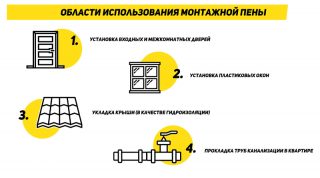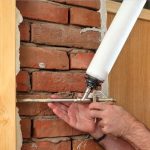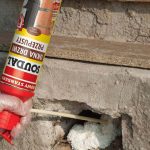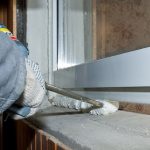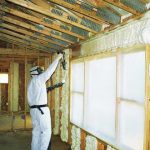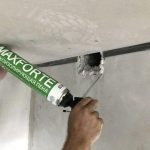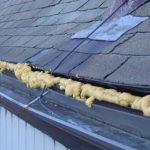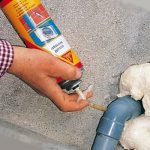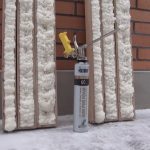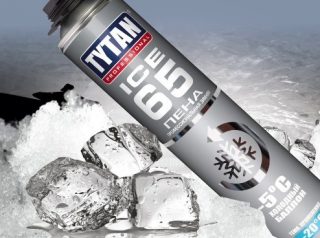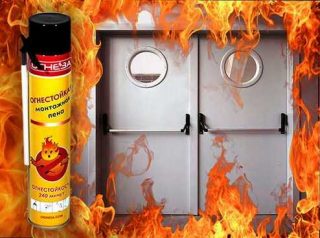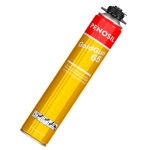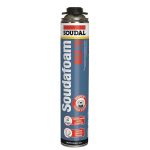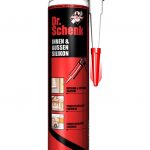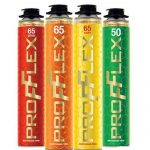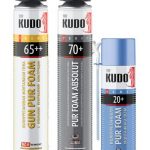Polyurethane foam - polyurethane insulation in an aerosol can. Builders note the ease of use and speed of solidification. Foam can be fire-resistant, frost-resistant, have different density, hygroscopicity, coefficient of expansion, differ in drying time.
Description and purpose of polyurethane foam
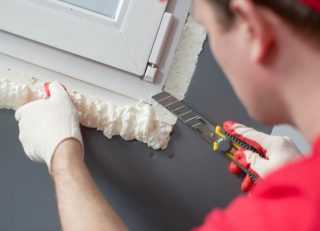
Polyurethane foam sealant belongs to the category of household chemicals intended for insulation and sealing of butt joints during the installation of various structures. The outlet volume is determined by the amount of mass obtained from the container and the foam. The value depends on the temperature of the surrounding space and the cylinder, the humidity of the surface and air.
In production use components:
- MDI (methylene definyl diisocyanate);
- polyols;
- foaming agents;
- stabilizers;
- catalysts.
The degree of adhesion indicates the strength of the bond to the substrate to which it is applied. Polyurethane foam adheres well to almost all building materials, except for Teflon, silicone, glass, polyethylene, greasy and icy surfaces.
Foam can change stability in space after completion of polymerization:
- sit down - the degree depends on the density of the substance, the exceeded volume of the filler (ballast) or the overabundance of open links inside the material;
- further expand - due to high temperatures and a large number of closed cells.
The change in size is caused by a violation of technology, when the substance is applied to an uncleaned surface, and insufficient moisture. Dimensional instability occurs if foam is used for internal use in frosty conditions.
The viscosity of polyurethane foam depends on the consistency, is determined when the temperature drops below + 12 ° С or increases more than + 35 ° С. A low-quality working mass loses its density, the effectiveness of insulation decreases.
Scope of application
Main application area:
- sealing joints from moisture, blowing;
- insulation of the gaps between the structural elements of the building;
- sealing of cracks;
- gluing polystyrene, expanded polystyrene and other board materials on walls, floors, ceilings;
- insulation of gaps from external sound vibrations.
Foam is used when installing wooden and plastic (PVC) windows, since the material does not absorb water, but conducts steam.
Other caseswhen the choice falls on polyurethane foam:
- sealing gaps between panels or wall fillings in frame structures;
- thermal insulation when laying heating lines;
- insulation of ventilation ducts and air conditioning systems in buildings;
- sealing of exit points from the walls of the water supply system, sewerage, chimney channels.
Aerosol polyurethane foam effective in repair work... Due to the rapid expansion and setting, the material is convenient to use in the event of cracks, delamination of slab insulation, it is chosen for gluing ceramics, stone, window sills, countertops, ebb tides, and other decorative elements.
Composition and characteristics
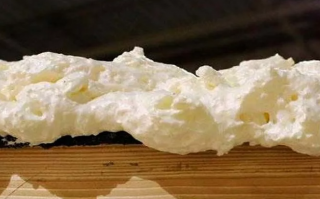
Foaming means boiling of the prepolymer mass when ejected from the container, followed by stabilization in the foamed state.
The polyurethane foam contains active ingredients:
- Prepolymers. These are manufactured products obtained by the interaction of functional organic compounds (methylene definyl diisocyanates, MDI) and polyalcohols. The reaction takes place inside the aerosol container.
- Propellants. They are represented by a gas mixture, which is partially in liquid form, to some extent combined with prepolymers. When the mass exits the balloon, the substance is pushed out, a foam is formed.
Until foaming time, a mixed liquid of prepolymers and propellants is present inside. The second substance is capable of boiling at low temperature and high pressure, due to which foam is obtained. The form of the released substance is fixed due to active surface components (more often, silicones).
Lack of activators results in cell collapse, combining them into large links, therefore, extensive cavities appear in the mass. Foaming agents in the composition open such cavities, release gas, so that the seam formation process occurs evenly.
Expansion occurs during polymerization, when the prepolymer is in contact with air or surface moisture, and carbon dioxide is released in the form of a gas. Manufacturers try to reduce uncontrolled expansion by coordinating the blowing agent.
A useful characteristic of polyurethane foam is that during work, not the entire gap is closed, but only a third part... The rest of the volume is filled with expansion, while the insulator self-compresses in the joint space.

Varieties of polyurethane foam
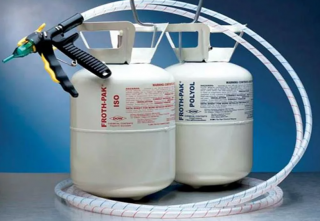
Foam according to the degree of readiness for use is divided into one-component and two-component views. Previously, only one-component foam was produced. During production, the components were mixed in the factory, and packed in aerosol containers. The disadvantage of such products is the short storage time without opening (about a year).
Two-component types involve storing the polyol and isocyanate in different containers until the period of use comes. The components are mixed, so the shelf life of this option is significantly different (up to three years). The disadvantage is the lower output volume compared to the one-component version.
Method of use also underlies the division of foam into types:
- professional use (with a pistol);
- household models (with a removable tube).
By the degree of flammability there are foams: fire-fighting (class B1), self-extinguishing (class B2), combustible foams (class B3). Winter polypropylene differs in composition from summer... After hardening, all varieties expand the holding range, but it is better to work with foam at temperatures not lower than -10 ° C (summer versions are used at temperatures above + 5 ° C).
Foam for indoor use does not withstand low temperatures, it crumbles in the cold, and the foam mass does not acquire a stable shape. Winter compositions can be foamed at low air humidity (30 - 40%), while summer ones require relative indicators of 50 - 60%.
Criterias of choice
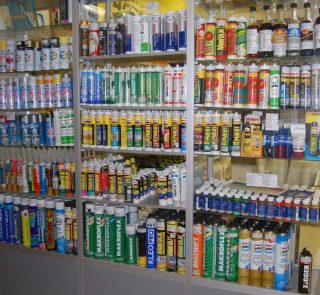
The quality of the product depends on the degree of expansion, this indicator is taken into account when purchasing an insulator.
Distinguish characteristics:
- primary expansion - how many times the volume of the mixture increases when it comes out into the air;
- secondary build-up rate - the degree of increase after polymerization and stabilization;
- density - for household varieties, the value is lower than that of professional cylinders;
- viscosity shows the fluidity of the foam in the seam material;
- shrinkage of material, expressed as a percentage, shows a decrease in residual volume compared to the initial expansion.
On the cylinders, the numbers 70, 60, 50 are indicated - they indicate the volume of the mixture output. The indicator means the cubic capacity of the material in liters, which can be obtained from a specific container. This output is valid at ideal humidity (50%) and temperature (+ 5 ° - + 35 ° C).
The time for complete drying shows the period after which finishing work is started.

Manufacturers overview
Depending on the quality and popularity, it is compiled polyurethane foam manufacturers rating:
- Soudal - the Belgian company has offices in different countries. It belongs to the leaders in the production of sealing materials.
- Penosil - the brand belongs to the Krimelte concern, which produces the following types: Gold, Premium, Standard. The catalog presents frost-resistant, fire-resistant and versatile products.
- Dr. Scenk - German manufacturers have been working on the market for more than 80 years, therefore, representative offices are developed in different countries of Europe and Asia. The range includes a variety of seals, including professional options and household cylinders.
Top Russian manufacturers includes brands: Proflex, Kudo (CJSC Elf Filling), Premium (LLC De Lux), Premium Product, LLC Vlad PromPen.

